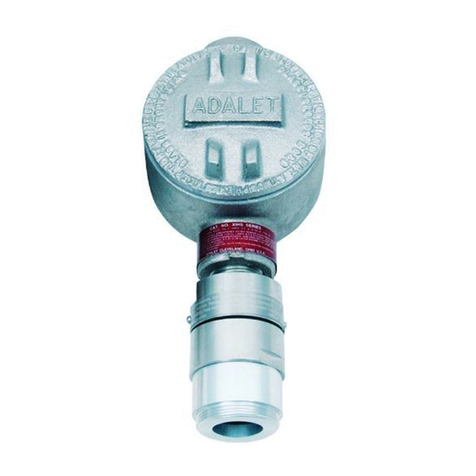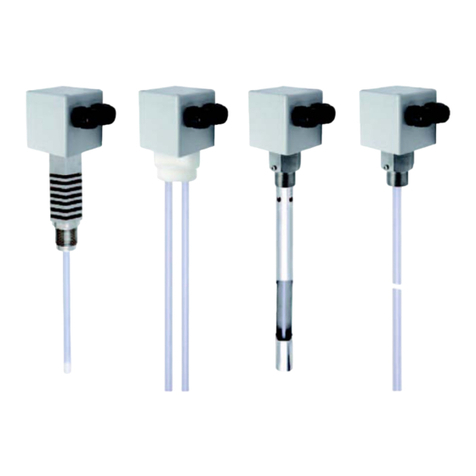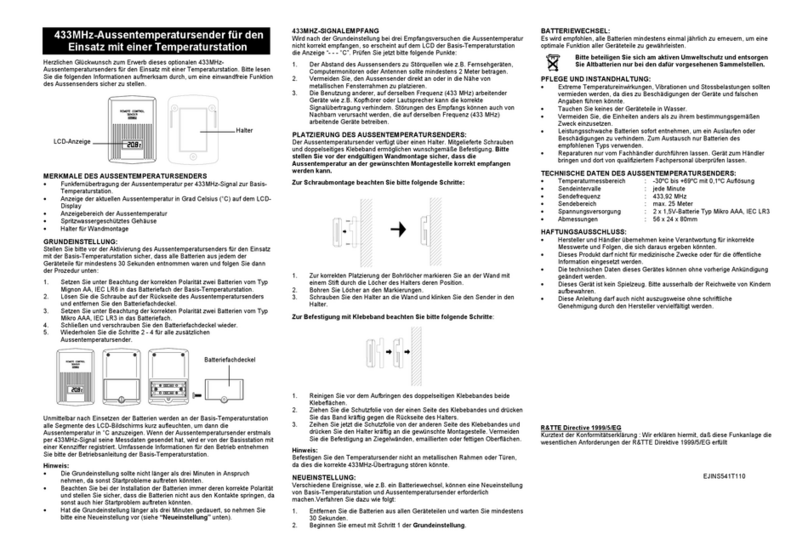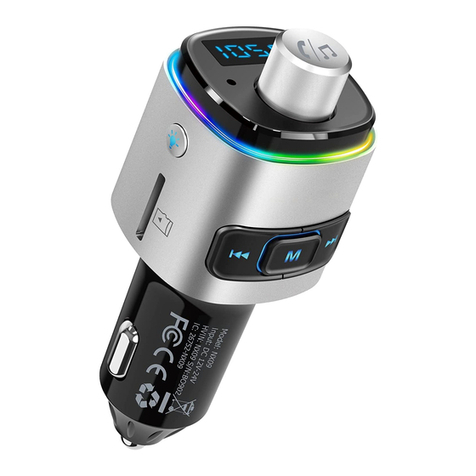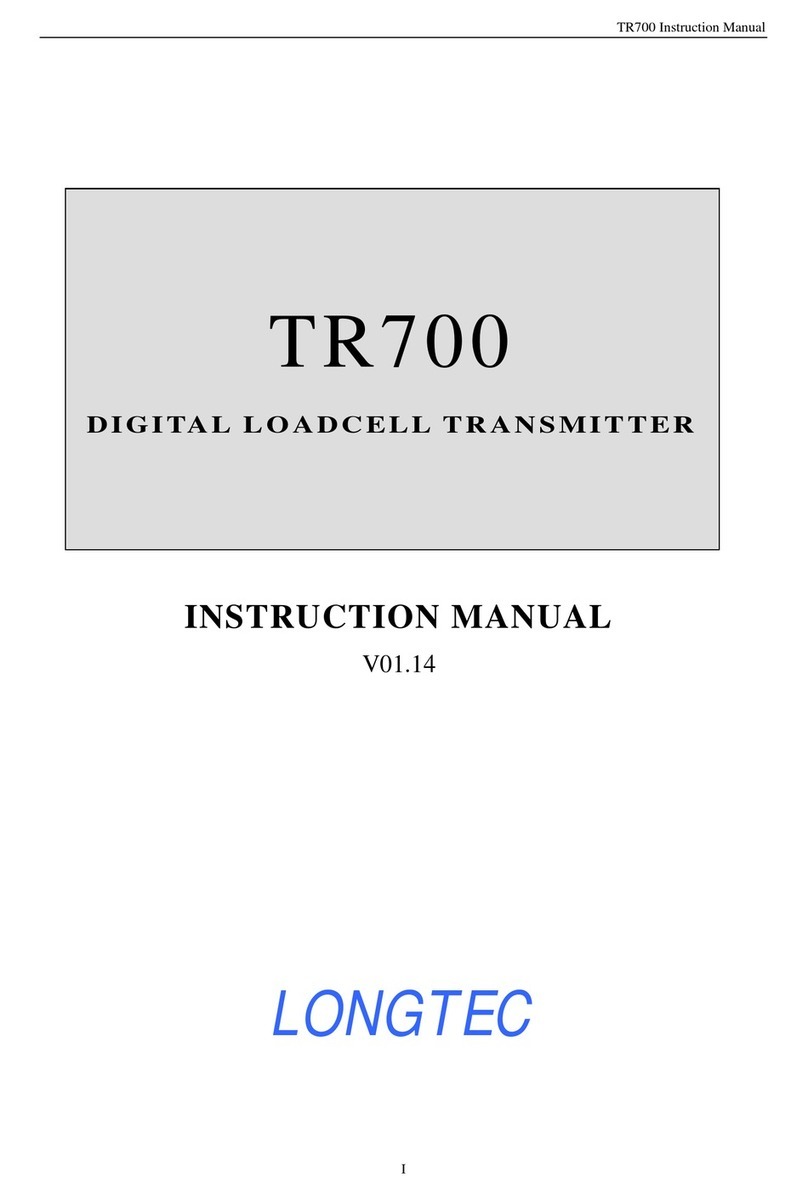SURE-FI Relay PRO Bridge User manual

2
SURE-FI, INC. |www.sure-fi.com
Sure-Fi Relay PRO Bridge
Quick Startup
The two units that are packaged together are factory paired and will only
communicate with each other.
Check initial operation
Connect a9V battery (not included) to the 9V cable (included) and plug the two-position connector into the
‘+VIN’and ‘-VIN’ positions on the bottom edge connector. Once both units are powered up, the green POWER
LED should be ON steady on each unit.Momentarily press the ‘TEST’button on either unit to test
communication between the two units. One or more of the blue Signal Strength LEDs should light up for one
second to indicate that successful communication hasoccurred between the two units.
Perform aRange-Test from the desired install locations
With the 9V batteries plugged in to each of the units, place them at the desired install location pointsand
perform aRange-Test by momentarily pressing the ‘TEST’ button. The received signal strength is displayed for
one second on the six blue LEDs with the bottom blueLED indicating the minimum signal strength and all six
LEDs indicating maximum signal strength.
Connect to permanent power
Connect the desired permanent powersource at each unit and perform several Range-Tests to check for
adequate input power.
Wire the input and output functions
Wire the desired devices at each unit.
The maximum voltage that can be applied to any of the
relay inputs(R1AIN – R8AIN / R1BIN –R8BIN)is 5VDC. A
dry contact closure or a 0 to 5VDC digital interface are
acceptable.

3
SURE-FI, INC. |www.sure-fi.com
Sure-Fi Relay PRO Bridge
Table of Contents
Part Numbers Pg. 5
Overview Pg. 5
Key Features Pg. 5
General Specifications Pg. 6
Radio Transceiver Specifications Pg. 6
Device Overview, Relay PRO UNIT A
Device Overview, Relay PRO UNIT B
Pg. 7
Pg. 8
UNIT A – Top &Bottom Connector pin descriptions Pg. 9 - 10
UNIT B – Top &Bottom Connector pin descriptions Pg. 11 - 12
Relays Pg. 13
The Test Push Button (Range Test) Pg. 13
Connector plug part number information Pg. 13
Chain Multiple system pairs for extended range Pg. 13
Mounting Pg. 14 – 15
Sure-Fi App –downloading, installing, connecting Pg. 16
Sure-Fi App –Firmware Updating Pg. 16
Sure-Fi App –Setting System Heartbeat, Relay Defaults and Timeout Pg. 17
Setting arelay as an RF-Link /Alert Relay Pg. 17
Troubleshooting Pg. 18
FCC and Industry Canada Regulatory Statements Pg. 19
Warranty Pg. 20

4
SURE-FI, INC. |www.sure-fi.com
Sure-Fi Relay PRO Bridge
Figure Reference Guide
Figure 1: Device Overview, UNIT A Pg. 7
Figure 2: Device Overview, UNIT B Pg. 8
Tables 1 and 2: Top Edge UNIT A ConnectorsP1 and P2 Pg. 9
Tables 2and 3: Bottom Edge UNIT A Connectors P3 and P3 Pg. 10
Tables 1 and 2: Top Edge UNIT B ConnectorsP1 and P2 Pg. 11
Tables 3 and 4: Bottom Edge UNIT B Connectors P3 and P4 Pg. 12
Figure 3: DIN Clips used for screw mount Pg. 14
Figure 4: DIN clip screw mount option top clip Pg. 15
Figure 5: DIN clip screw mount option bottom clip Pg. 15

5
SURE-FI, INC. |www.sure-fi.com
Sure-Fi Relay PRO Bridge
Part Numbers
DS010-RELAYPRO Relay PRO Bridgesystem: includes 1ea. SFI-RP601-01 &SFI-RP602-01
SFI-RP601-01 Relay PRO UNIT A
SFI-RP602-01 Relay PRO UNIT B
Overview
The Sure-Fi DS010-RELAYPRO system consists of two factory paired units that are ready to use with no
configuration required. TheRelay PRO UNIT A Interface wires to the Control Panel and communicates
wirelessly to the Relay PRO UNIT B Interface, which is placed out at the peripheral and any relay/switch
activated device. The Sure-Fi App provides for configuration, diagnostics,andfield firmware updates.
Key Features
Includes complete wireless solution for up to eight relay activated devices on each unit
Range: up to 1mile through obstructions and greater than 50 miles line-of-sight
Relays: seven FORM Cand one FORM Arelays on each unit
Chain multiple system pairs for extended range
DIN rail mount or direct wall mount
Sure-Fi App connects via Bluetooth for diagnostics and firmware updates

6
SURE-FI, INC. |www.sure-fi.com
Sure-Fi Relay PRO Bridge
General Specifications
Operating Voltage: 12 to 30VAC/DC
Operating Current (@ 24VAC): 0.02A (idle), 0.26A(transmit)
Operating Power (@ 24VAC): 6.3VA (peak)
Relay Inputs (R1IN –R8IN): Dry contact or digital 0to 3.3VDC/5.0VDC interface
Relays 1 & 2: Two Form CMechanical Relays, 5A 220VDC /250VAC
Relays 3 – 7: Five Form Csolid state relays, 2A 30VDC /30VAC
Note: Maximum allowable combined current is 3A
Relay 8: One Form Asolid state Relay, 0.75A 30VDC / 30VAC
Range: Up to 1mile through obstructions. Greater than 50 miles line-of-sight
Can chain multiple system pairs for extended range
Encryption: AES128
Operating Temperature: -40°F to +158°F (-40°C to +70°C)
Storage Temperature: -67°F to +257°F (-55°C to +125°C)
Humidity: 0to 85% non-condensing
Dimensions (L x W x H): 3.54” x 5.30” x 1.28” (90mm x 135mm x32.5mm)
DIN mount type: 35mm DIN rail (DIN46277-3) /(DIN35)
Degree of Protection: IP20 to IEC/EN 60529
Radio Transceiver Specifications
Transmit Power: 1Watt (30dBm)
Frequency Band: 902 –928MHz
Channels:72 (FHSS)
Receiver Sensitivity: -133dbm
Link Budget: 163dB

9
SURE-FI, INC. |www.sure-fi.com
Sure-Fi Relay PRO Bridge
Relay Pro UNIT AInterface connectors
Table 1: Top Edge UNIT A connector P1. See Figure 1for connector location and pin numbers
CONNECTOR
P
OSITION
NAME
DESCRIPTION
P1 1R2ANC Relay 2A Normally-Closed terminal
P1 2 R2ACOM Relay 2A Common terminal
P1 3 R2ANO Relay 2A Normally-Open terminal
P1 4 GND Ground
P1 5 R2BIN Relay 2UNIT BInput
P1 6 GND Ground
P
1
7
R1
B
IN
Relay
1
UNIT
B
Input
P1 8 R1ANC Relay 1A Normally-Closed terminal
P1 9 R1ACOM Relay 1A Common terminal
P1 10 R1ANO Relay 1A Normally-Open terminal
Table 2: Top Edge UNIT A connector P2. See Figure 1for connector location and pin numbers
CONNECTOR
P
OSITION
NAME
DESCRIPTION
P2 1 R4A NC Relay 4A Normally-Closed terminal
P2 2 R4A COM Relay 4A Common terminal
P2 3 R4A NO Relay 4A Normally-Open terminal
P2 4 GND Ground
P
2
5
R
4B
IN
Relay
4
UNI
T
B
Input
P2 6 GND Ground
P2 7 R3B IN Relay 3UNIT BInput
P2 8 R3A NC Relay 3A Normally-Closed terminal
P2 9 R3A COM Relay 3A Common terminal
P2 10 R3A NO Relay 3A Normally-Open terminal

10
SURE-FI, INC. |www.sure-fi.com
Sure-Fi Relay PRO Bridge
Relay Pro UNIT Aconnectors (cont.)
Table 3: Bottom Edge UNIT A connector P3. See Figure 1for connector location and pin numbers
CONNECTOR
P
OSITION
NAME
DESCRIPTION
P3 1+VIN +VDC input or VAC input
P3 2 -VIN -VDC input or AC common input
P
3
3
R8A
NO
Relay
8A
Normally
-
Open
terminal
P3 4 R8A COM Relay 8A Common
P3 5 R8B IN Relay 8B UNIT BInput
P3 6 GND Ground
P3 7 R7B IN Relay 7B UNIT BInput
P3 8 R7A NC Relay 7A Normally-Closed terminal
P3 9 R7A COM Relay 7A Common terminal
P
3
10
R7A
NO
Relay
7A
Normally
-
Open
terminal
Table 4: Bottom Edge UNIT A connector P4. See Figure 1for connector location and pin numbers
CONNECTOR
P
OSITION
NAME
DESCRIPTION
P4 1R6A NC Relay 6A Normally-Closed terminal
P4 2 R6A COM Relay 6A Common terminal
P4 3 R6A NO Relay 6A Normally-Open terminal
P
4
4
GND
Ground
P4 5 R6B IN Relay 6UNIT BInput
P4 6 GND Ground
P4 7 R5B IN Relay 5UNIT BInput
P
4
8
R5A
NC
Relay
5A
Normally
-
Closed
terminal
P4 9 R5A COM Relay 5A Common terminal
P4 10 R5A NO Relay 5A Normally-Open terminal

11
SURE-FI, INC. |www.sure-fi.com
Sure-Fi Relay PRO Bridge
Relay Pro UNIT BInterface connectors
Table 5: Top Edge UNIT B connector P1. See Figure 2for connector location and pin numbers
CONNECTOR
P
OSITION
NAME
DESCRIPTION
P1 1R2B NC Relay 2B Normally-Closed terminal
P1 2 R2B COM Relay 2B Common terminal
P1 3 R2B NO Relay 2B Normally-Open terminal
P1 4 GND Ground
P1 5 R2A IN Relay 2UNIT AInput
P1 6 GND Ground
P
1
7
R1A
IN
Relay
1
UNIT
A
Input
P1 8 R1B NC Relay 1B Normally-Closed terminal
P1 9 R1B COM Relay 1B Common terminal
P1 10 R1B NO Relay 1B Normally-Open terminal
Table 6: Top Edge UNIT B connector P2. See Figure 2for connector location and pin numbers
CONNECTOR
P
OSITION
NAME
DESCRIPTION
P2 1R4BNC Relay 4B Normally-Closed terminal
P2 2 R4BCOM Relay 4B Common terminal
P2 3 R4BNO Relay 4B Normally-Open terminal
P2 4 GND Ground
P
2
5
R4
A
IN
Relay
4
UNIT
A
Input
P2 6 GND Ground
P2 7 R3AIN Relay 3UNIT AInput
P2 8 R3BNC Relay 3B Normally-Closed terminal
P2 9 R3BCOM Relay 3B Common terminal
P2 10 R3BNO Relay 3B Normally-Open terminal

12
SURE-FI, INC. |www.sure-fi.com
Sure-Fi Relay PRO Bridge
Relay Pro UNIT Bconnectors (cont.)
Table 7: Bottom Edge UNIT B connector P3. See Figure 2for connector location and pin numbers
CONNECTOR
P
OSITION
NAME
DESCRIPTION
P3 1+VIN +VDC input or VAC input
P3 2 -VIN -VDC input or AC common input
P
3
3
R8
B
NO
Relay
8
B
Normally
-
Open
terminal
P3 4 R8BCOM Relay 8B Common
P3 5 R8AIN Relay 8UNIT AInput
P3 6 GND Ground
P3 7 R7AIN Relay 7UNIT A Input
P3 8 R7BNC Relay 7B Normally-Closed terminal
P3 9 R7BCOM Relay 7B Common terminal
P
3
10
R7
B
NO
Relay
7
B
Normally
-
Open
terminal
Table 8: Bottom Edge UNIT B connector P4. See Figure 2for connector location and pin numbers
CONNECTOR
P
OSITIO
N
NAME
DESCRIPTION
P4 1R6BNC Relay 6B Normally-Closed terminal
P4 2 R6BCOM Relay 6B Common terminal
P4 3 R6BNO Relay 6B Normally-Open terminal
P
4
4
GND
Ground
P4 5 R6AIN Relay 6UNIT AInput
P4 6 GND Ground
P4 7 R5AIN Relay 5UNIT AInput
P
4
8
R5
B
NC
Relay
5
B
Normally
-
Closed
terminal
P4 9 R5BCOM Relay 5B Common terminal
P4 10 R5BNO Relay 5B Normally-Open terminal

13
SURE-FI, INC. |www.sure-fi.com
Sure-Fi Relay PRO Bridge
Relays
Operating the relays
The relay outputs are operated by the corresponding relay inputs that are on the paired unit. For example, to
energize Relay 1A on UNIT A, the Relay 1A input (R1AIN)on the UNIT B must be shorted to ground (0VDC)
using adry contact switch (relay closure,push-button, etc.),or adigital voltage 0to 3.3VDC or 0to 5VDC
interface.This can be tested by connecting aswitch or ajumper wire to the R1AIN and GND and then
monitor Relay 1A output on UNIT A for activation of the relay.Each relay output has acorresponding LED that
will illuminate when the relay is in the activated (energized) state.
Relay In/out control
Relays 1A – 8A located on UNIT Aare operated by R1AIN -R8AIN on UNIT B.
Relays 1B – 8B located on UNIT B are operated by R1BIN -R8BIN on UNIT A.
The Test Push Button (Range Test)
Range Test: Pressing and releasing the ‘Test’ button quickly initiates the Range Test. The Range Test feature is
used to test the signal strength of the radio transceiver with the paired unit and displays the results of a
received transmission on the six blue LEDs, these are labeled ‘Signal Strength LEDS (1 –6)’ in Figure 1.
Maximum signal strength is indicated when LEDs 1through 6all flash ON and minimum signal strength is
indicated when only LED 1flashes ON
Antenna
The radio antenna is created using copper traces on both sides of the PC Board. Use caution when handling
and mounting the unit to ensure that no damage (scratches, etc) occurs to the PC Board/Antenna.
Additionally, for best performance, keep cables and wiring away from the antenna and mount the unit
oriented with the antenna upwards.
Connectors
The connectors are 3.5mm EURO type. The mating plug is Molex pn 39500-0010. Wire Range: 16 to 30AWG
stranded or solid.Wire strip length 0.250”. Recommended screwdriver: slotted blade 0.98”(2.5mm) width.
To install awire, turn the screw counter-clockwise 3or 4turns, insert the wire and hold in place while
tightening the screw. When complete, pull on the wire to ensure that it is tightened adequately.
Chain multiplesystem pairs for extended range
If asingle paired system is unable to communicate from the desired two endpoints, a second paired system
can be used to create a ‘chain’ to extend the range. If required, many paired systems can be ‘chained’
together for extremely difficult installations. To accomplish this, each paired system in the chain is wired to
another paired system to pass the signals between them.

14
SURE-FI, INC. |www.sure-fi.com
Sure-Fi Relay PRO Bridge
Mounting
DIN Rail mount
DIN rail mounting allows the unit to easily clip and unclip from the DIN rail. Attach apiece (minimum 5”
length) of 35mm type DIN rail to the wall and then snap the unit to the DIN rail or slide it on from the end.
The unit will snap in to place by putting the top retaining tabs on to the DIN rail first, then pressing the bottom
on to the DIN rail until it snaps in to place, the bottom DIN clip may need to be pressed upward to seat into its
locked position. To remove the unit from the DIN rail, use asmall screwdriver, insert in to the bottom DIN rail
clip and pull gently down and outward until the unit releases from the DIN rail.
Screw mount
The DIN rail clips on the base of the enclosure case can be snapped outward to allow for screw mounting of
the case. Mount using only the single bottom DIN clip and the top DIN clip that is located on the side below
connector P1. Do not use the DIN clip located behind the antenna. See Figures 9, 10,and 11.
If mounting the unit to metal, take note that metal shavings that are created can drop into the unit and
damage the electronics. To avoid any metal shavings from dropping down in to the case, it is recommended
to remove the top DIN clip completely from the base and secure it to the wall first, then slide the case on to
the DIN clip. The second screw can then be secured through the bottom DIN clip without removing the clip.
#8 self-drilling screws are recommended. Do not use any screw that is larger than a#8 size.
Figure 9: The two DIN clips are shown pressed outward and ready for screw mounting:

16
SURE-FI, INC. |www.sure-fi.com
Sure-Fi Relay PRO Bridge
Sure-Fi App
The Sure-Fi App for iOS andAndroid allows for firmware updates, configuration and customization as well as
for some diagnostics and troubleshooting information. The App is continually being updated to provide for
more information and features and to improve its ease of use. To download, search for ‘Sure-Fi’ and then
download and install. The key features of the App are:
Field firmware updates
Configure the six Signal Strength LED indicators for ON/OFF, persistence time (default is ON, 1second)
Setting default Relay output values upon aset timeout interval (in increments of the Heartbeat time).
Setting the system Heartbeat time.
Diagnostics and Troubleshooting information
Access to documentation (Operators Manual, Application Notes, Reference documents,etc.)
Using the Sure-Fi App
Connecting
The Sure-Fi App uses the Bluetooth on the user’s phone to connect to the Bridge’s onboard Bluetooth
interface. To use the App,be sure that the unit is powered ON, then open the App,then scan the QR code
that is on the unit next the ‘TEST’ button. The Status will show ‘Connecting’, then after a pause it will say “Hold
Test button on the Bridge for 5seconds”. If the connection is successful, the status will show ‘Status:
Connected’ and all the features of the App will be available for use.
Firmware Updating
Firmware updates must be completed on both UNIT Aand UNIT Bwhen updating the firmware of either side.
The Bridge pair may operate erratically or be non-functional until both sides have been updated to anew
firmware version. If updating firmware on one side, plan to immediately go to the other side and perform the
same firmware update.
Adata connection must be available on the device (phone) that the Sure-FI App is running on. Be sure that
the App remains connected to the Bridge unit during the update process which usually takes acouple minutes
to complete. After connecting to the Bridge unit with the App,select ‘Update Firmware’ from the menu. The
‘Update Firmware’ screen will show the current firmware versions and show if a newer released version is
available. Select ‘Start Firmware Update” to begin the updating process. Anotification will be given when the
update is complete. When complete, close the App and then power-cycle the unit.

17
SURE-FI, INC. |www.sure-fi.com
Sure-Fi Relay PRO Bridge
Setting the System Heartbeat time
The system Heartbeat is the time interval when the system will automatically perform asystem status check if
there have not been radio communications between the units during that time. The Heartbeat timer is reset
eachtime any successful transmission occurs between units during regular usage. The Heartbeat system
status check verifies communication between units and that all output states correspond correctly with the
given inputs. If aunit does not receive the Heartbeat, it will continue to attemptcommunications and it will
keep all outputs set at their current state unless any of the outputs have been set for fail-safe values using the
Sure-Fi App. In that case, the unit will set the output values as configured when the set time interval is
reached. The Heartbeat time interval and the number of Heartbeats that can be missed are configurable with
the App.
Setting aRelay default state and timeout
This feature is defaulted from the factory as disabled. With Relay default state disabled, the relays will remain
in their current state during any time that communications with the paired unit are interrupted. The relays
can be set to default as activated or deactivated after aset time interval has passed if communication with the
paired unit is interrupted. The time interval is based on multiples of the Heartbeat time. When the time
interval is reached, the relay(s) will go to the selected default state (activated or deactivated) as configured in
the Sure-Fi App and will remain in that state until regular system activity returns. This feature provides away
to define the relay default state if communications between units is interrupted for aperiod of one or more
Heartbeat time intervals.
Setting arelay as an RF-Link or Alert Relay
An RF-Link/Alert Relay is amethod of monitoring one of the system relays to indicate if the RF
communications with the paired unit is lost and to indicate if power is lost on the Alert Relay unit.After
designating arelay to be used as the RF-Link/Alert Relay, open the Sure-Fi App and set the relay default state
as enabled and set the default state to be deactivated by setting the relay common terminal to show that it is
connected the relay NC terminal,save this setting and exit the App. Now, on the paired unit set the relay to
be ON/activated by shorting the relay input control to ground. For example, if using Relay 8A on UNIT Aas the
Alert Relay, set R8AIN on UNIT B with ajumper wire from R8AIN to the adjacent GND terminal. With R8AIN
on UNIT Bconnected to ground, the Relay 8A on UNIT A will be activated allowing the R8ANO to be shorted to
the R8ACOM terminal. The Relay 8A NO terminal will now remain shorted to the R8ACOM terminal until
either of the following two things occur: 1) RF communication with the UNIT B is lost for the designated
Heartbeat time and count as configured in the Sure-Fi App,2) power is lost at the UNIT A.

18
SURE-FI, INC. |www.sure-fi.com
Sure-Fi Relay PRO Bridge
Troubleshooting
Testing Range and RF communications
Press andrelease the ‘Test’ button on one of the units andobserve the six Signal Strength LEDs. If any of the
blue LED 1through LED 6lights up momentarily then the transmission between the two units was successful.
This establishes that the radio communications between the two units is operational and even with only the
LED 1, there is adequate signal strength for proper function.
For the best RF performance between units
1. Power both units with their own dedicated power supply.
2. Route all cables and wiring away from the area near the Antenna.
3. Avoid routing cables and wiring over the top of the unit.
4. Mount both units oriented with the antenna at the top of the unitfacing upwards.
5. Rotating either (or both) of the units may provide an improvement in range.
6. If additional range is required, avoid placing either unit on or near metal and place each unit at a
higher location.
Manually Testing Relays
Each relay can be manually tested to verify operation.Using aswitch or ajumper wire, short the relay input,
such as R1AIN to GND, then monitor the Relay 1A output on the bridge pair unit.This can be done on all eight
relays.

19
SURE-FI, INC. |www.sure-fi.com
Sure-Fi Relay PRO Bridge
FCC and Industry Canada Regulatory Statements
FCC
This device complies with part 15 of the FCC rules. Operation is subject to the following two conditions: (1) This device
may not cause harmful interference, and (2) this device must accept any interference received, including interference
that may cause undesired operation. Any changes or modifications not expressly Approved by manufacturer could void
the user’s authority to operate the equipment.
IMPORTANT! Any changes or modifications not expressly Approved by the party responsible for compliance could void
the user’s authority to operate this equipment.
Industry Canada
This device complies with Industry Canada license-exempt RSS standard(s). Operation is subject
to the following two conditions: (1) this device may not cause interference, and (2) this device
must accept any interference, including interference that may cause undesired operation of the
device.
Le présent Appareil est conforme aux CNR d’Industrie Canada Applicables aux Appareils radio exempts de licence.
L’exploitation est autorisée aux deux conditions suivantes: (1) l’Appareil ne doit pas produire de brouillage, et (2)
l’utilisateur de l’Appareil doit accepter tout brouillage radioélectrique subi, meme si le brouillage est susceptible d’en
compromettre le fonctionnement.
IMPORTANT! Tous les changements ou modifications pas expressément Approuvés par la partie responsable de la
conformité ont pu vider l’autorité de l’utilisateur pour actioner cet équipment.
47 CFR 15.105-FCC
NOTE: This equipment has been tested and found to comply with the limits for aClass Bdigital device, pursuant to part
15 of the FCC Rules. These limits are designed to provide reasonable protectionagainst harmful interference in a
residentialinstallation. This equipment generates, uses and can radiate radio frequency energy and, if not installed and
used in accordance with the instructions, may cause harmful interference to radio communications. However, there is
no guarantee that interference will not occur in aparticular installation. If this equipment does cause harmful
interference to radio or television reception, which can be determined by turning the equipment off and on, the user is
encouraged to try to correct the interference by oneor more of the following measures:
—Reorient or relocate the receiving antenna.
—Increase the separation between the equipment and receiver.
—Connect the equipment into an outlet on acircuit different from that to which the receiver
is connected.
—Consult the dealer or an experienced radio/ TV technician for help.
This Class Bdigital Apparatus complies with Canadian ICES-003.
Cet Appareil numérique de la classe Best conforme àla norme NMB-003 du Canada

20
SURE-FI, INC. |www.sure-fi.com
Sure-Fi Relay PRO Bridge
FCC Radiation Exposure Statement
This equipment complies with FCC radiation exposure limits set forth for an uncontrolled environment. This equipment
should be installed and operated with minimum distance 20cm between the radiator and your body.
Important Note:
Radiation Exposure Statement:
This equipment complies with IC radiation exposure limits set forth for an uncontrolled environment. This equipment
should be installed and operated with minimum distance 20cm between the radiator and your body.
Note Importante: (Pour l’utilisation de dispositifs mobiles)
Declaration d’exposition aus radiations:
Cet équipement est conforme aux limites d´exposition aux rayonnements IC établies pour un environnement non
contrôlé. Cet équipment doit être installé et utilisé avec un mimimum de 20 cm de distance entre la source de
rayonnement et votre corps.
Warranty
The warranty period of this product is 12 months run-time, beginning from first power up of the device after purchase. During this
period, if the product does not operate correctly, due to adefective component, the product will be repaired or replaced at the sole
discretion of Sure-Fi, Inc. This warranty does not extend to the product casing which can be damaged by conditions outside of the
control of Sure-Fi, Inc.
EXCEPT AS SET FORTH ABOVE, SURE-FI, INC. MAKES NO WARRANTIES REGARDING THE GOODS, EXPRESS OR IMPLIED, INCLUDING WARRANTY OF MERCHANTABILITY
OR WARRANTY OF FITNESS FOR APARTICULAR PURPOSE. BUYER MAKES NO RELIANCE ON ANY REPRESENTATIONOF SURE-FI, INC., EXPRESS OR IMPLIED, WITH
REGARD TO THE GOODS AND ACCEPTS THEM “AS-IS/WHERE-IS”. SURE-FI, INC SELLS THE GOODS TO BUYER ON CONDITION THAT SURE-FI, INC. WILL HAVE NO
LIABILITY OF ANY KIND AS ARESULT OF THE SALE. BUYER AGREES THAT SURE-FI, INC. SHALL HAVE NO LIABILITY FOR DAMAGES OF ANY KIND, WHETHER DIRECT,
INCIDENTAL OR CONSEQUENTIAL DAMAGES, INCLUDING INJURIES TO PERSONS OR PROPERTY, TO BUYER, ITS EMPLOYEES OR AGENTS, AS ARESULT OF THE SALE.
BUYER ALSO AGREES TO HOLD SURE-FI, INC. HARMLESS FROM ANY CLAIMS BUYER, OR ANY THIRD PARTY, MAY HAVE AS ARESULT OF BUYER’S USE OR DISPOSAL OF
THE GOODS. BUYER HAS READ THIS DISCLAIMER AND AGREES WITH ITS TERMS IN CONSIDERATION OF RECEIVING THE GOODS.
Trademarks
Sure‐Fi and the Sure‐Fi logo are registered trademarks.
Copyrights
©2020 Sure‐Fi, Inc. All rights reserved.
This manual suits for next models
5
Table of contents
Popular Transmitter manuals by other brands

Honeywell
Honeywell STT700 STT700 user manual
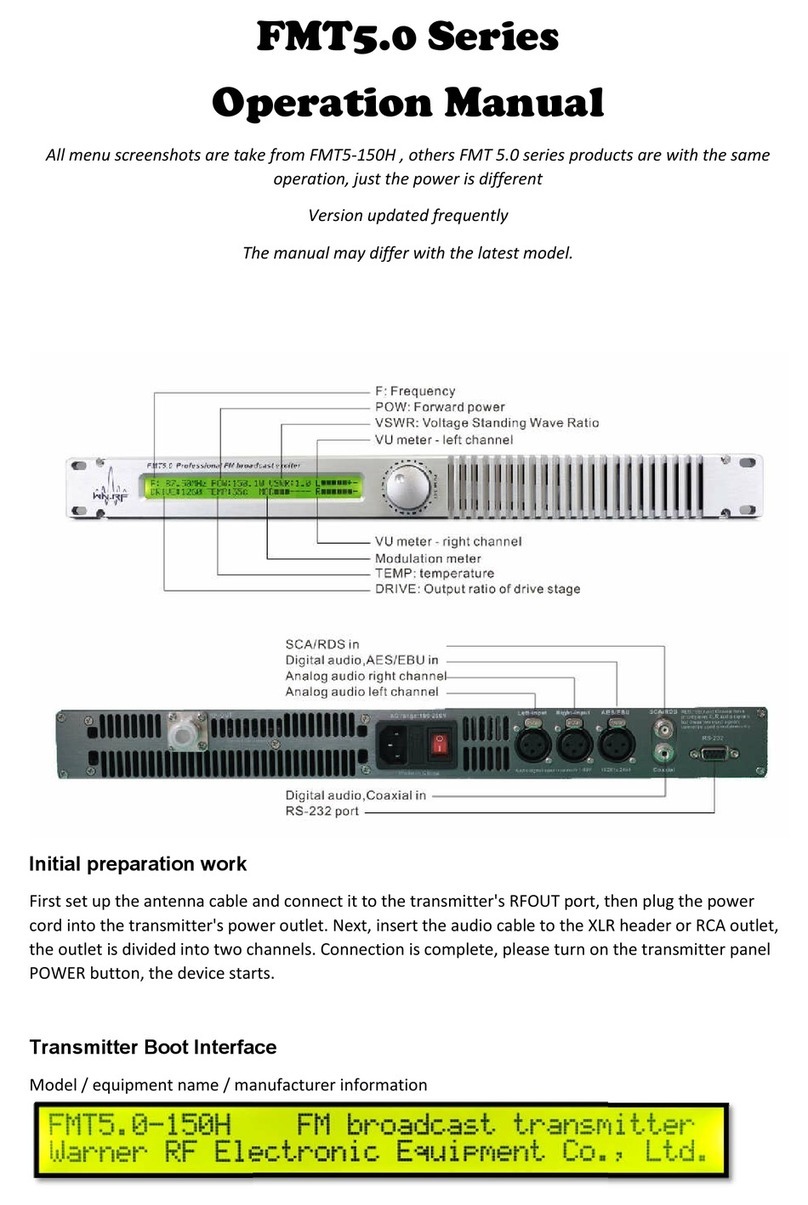
Warner RF
Warner RF FMT5.0 Series Operation manual
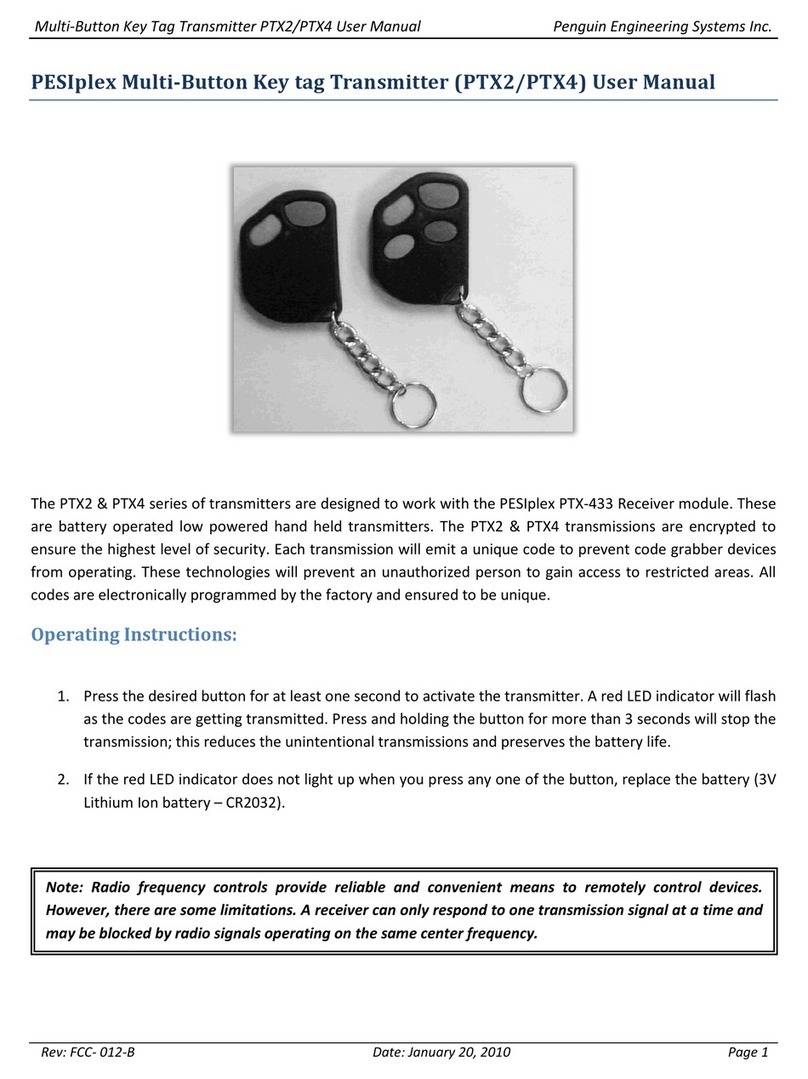
Penguin Engineering Systems
Penguin Engineering Systems PESIplex PTX2 user manual
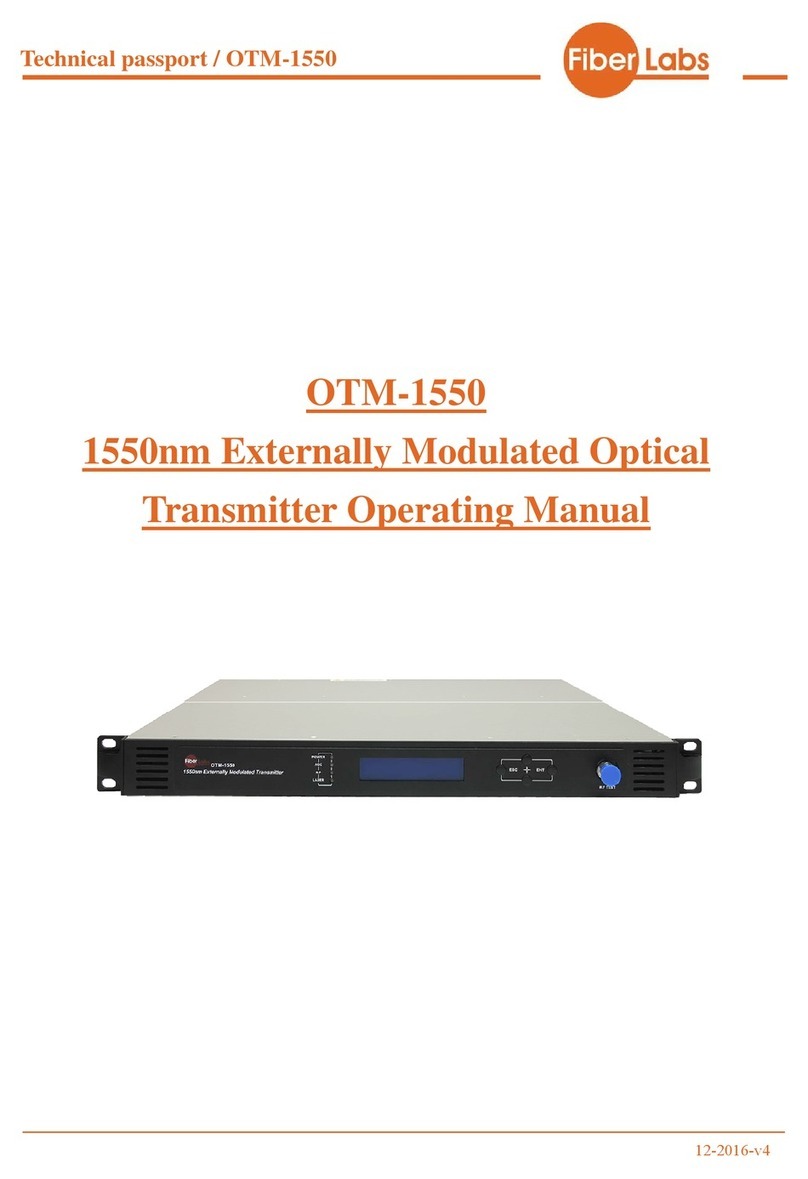
FiberLabs
FiberLabs OTM-1550 operating manual

LYNXTechnik
LYNXTechnik Yellobrik OTT 1842-1 quick reference
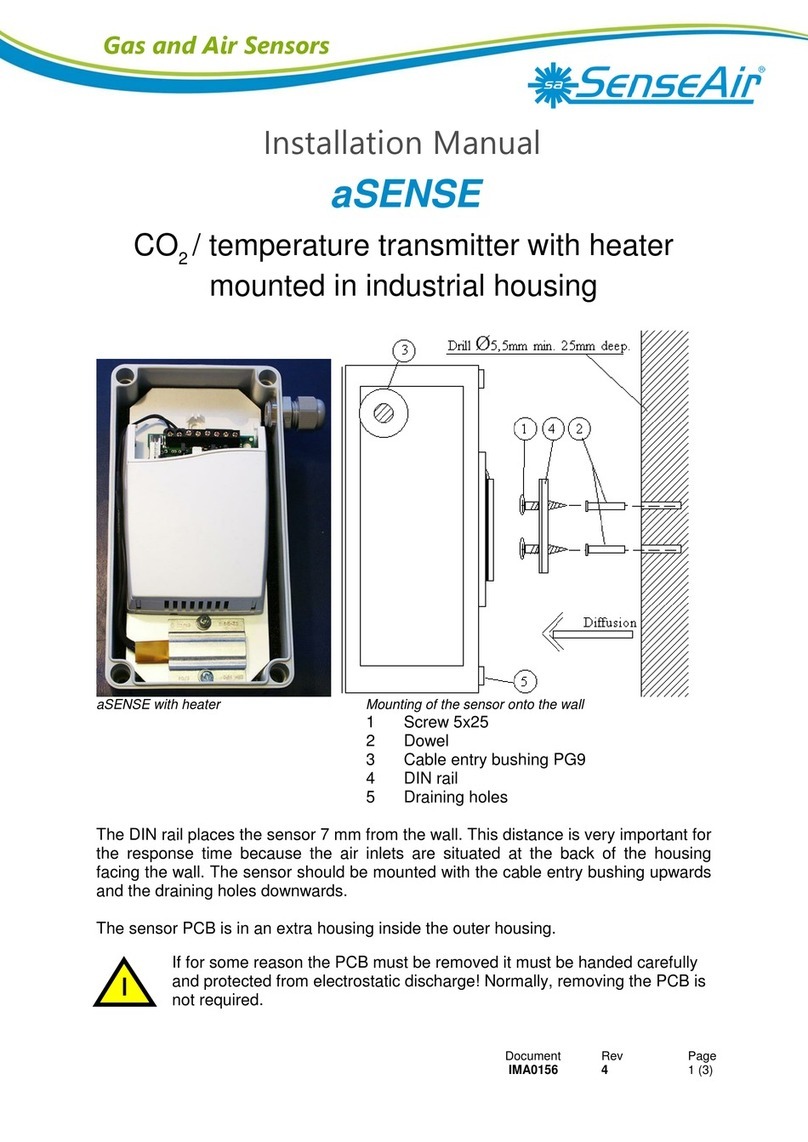
SenseAir
SenseAir aSENSE installation manual
ACS contsys
ACS contsys Sonicont USN050 Technical manual
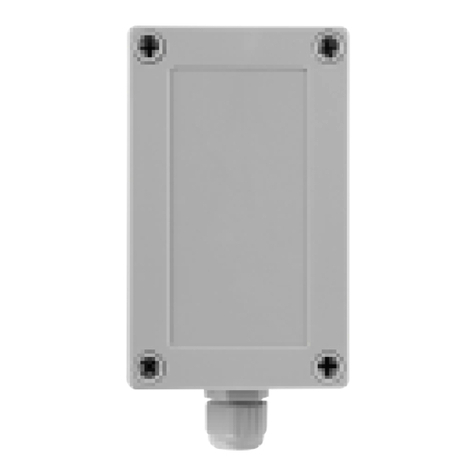
DAITEM
DAITEM 230-21X installation manual

Lectrosonics
Lectrosonics IFBT4 instruction manual
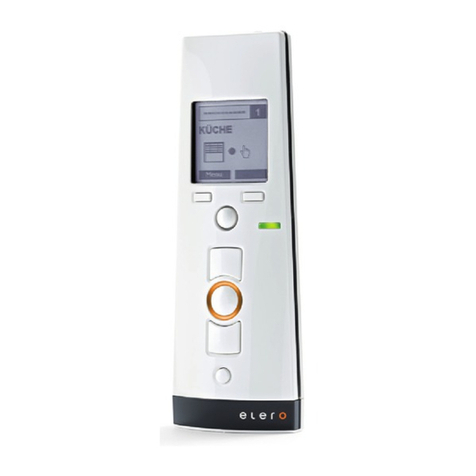
elero
elero TempoTel 2 operating instructions
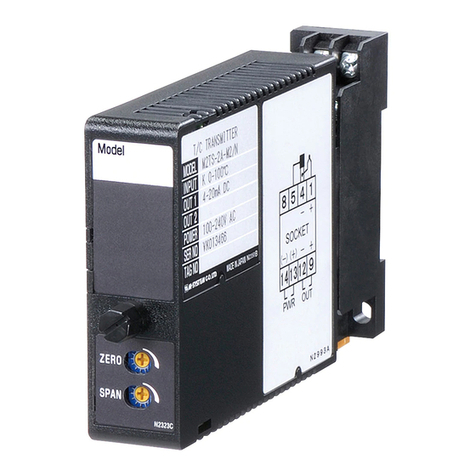
M-system
M-system Mini-M M2MS instruction manual
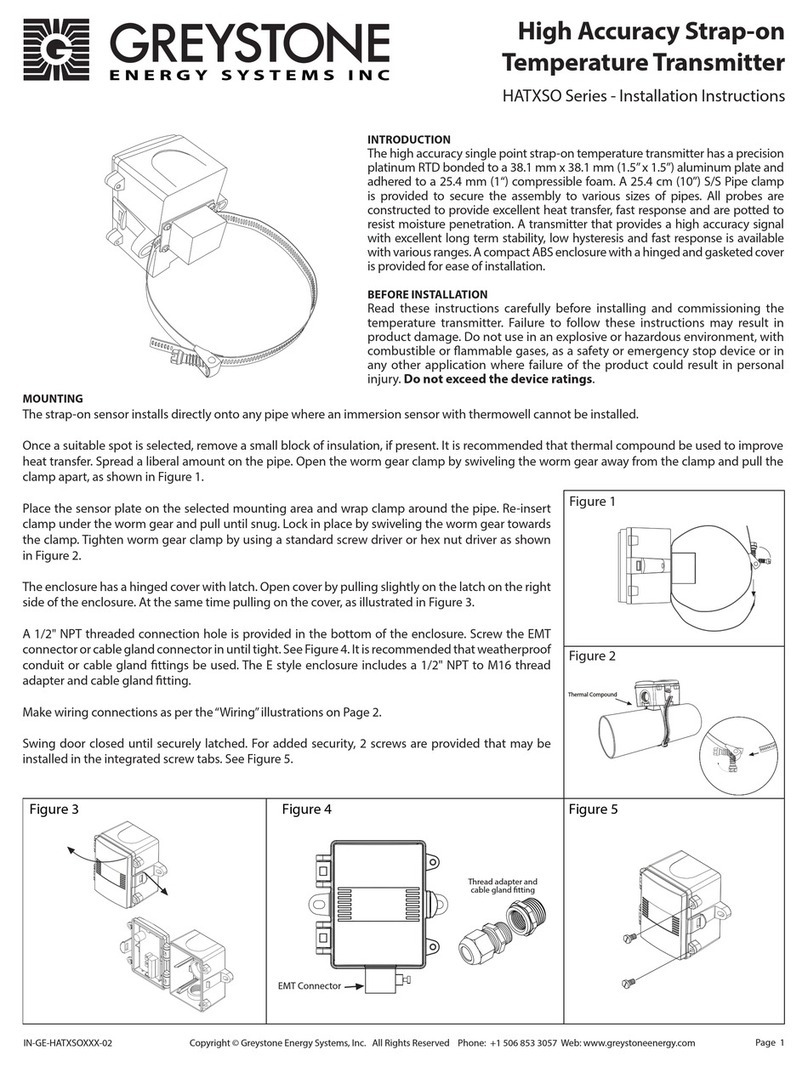
Greystone Energy Systems
Greystone Energy Systems HATXSO Series installation instructions




